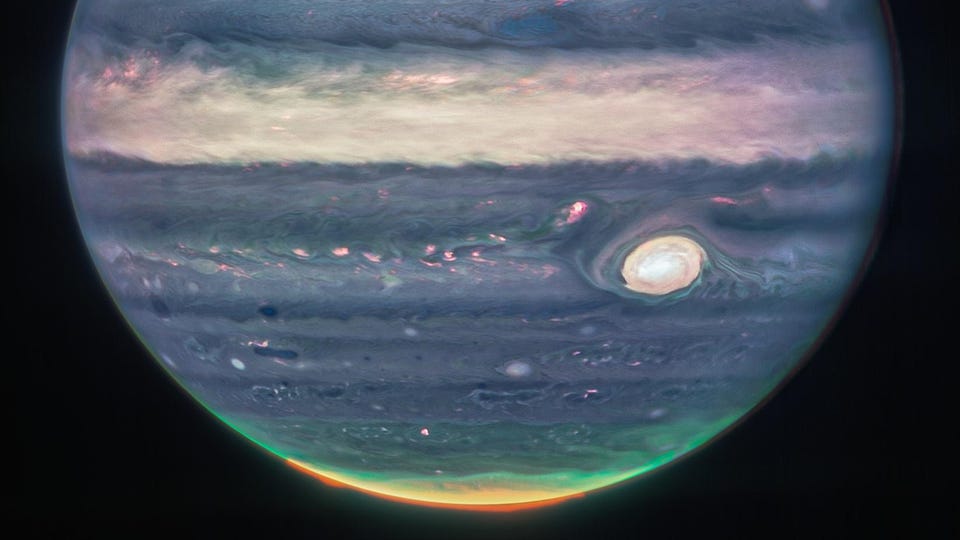Science Webb Telescope Drops Astonishing New Images Of Jupiter In Infrared Jamie Carter Senior Contributor Opinions expressed by Forbes Contributors are their own. I inspire people to go stargazing, watch the Moon, enjoy the night sky New! Follow this author to stay notified about their latest stories. Got it! Aug 22, 2022, 12:01pm EDT | New! Click on the conversation bubble to join the conversation Got it! Share to Facebook Share to Twitter Share to Linkedin James Webb Space Telescope images of Jupiter display a stunning wealth of detail.
A filter sensitive . . .
[+] to auroral emission from ionized hydrogen (mapped into the red channel) reveals auroral ovals on the disk of the planet that extend to high altitudes above both the northern and southern poles. Image credit: NASA, European Space Agency, Jupiter Early Release Science team. Image processing: Judy Schmidt Behold the first beautiful images of Jupiter from the James Webb Space Telescope (JWST) showing the giant planet’s incredible storms, cloud bands, faint aurora, rings and tiny moons—and all against a backdrop that features distant galaxies.
It comes not only days aft er NASA’s Juno spacecraft returned some incredible new images of the giant planet, but only weeks after the first incredible images from JWST , stunning images of the Cartwheel Galaxy and an image featuring “Earendel,” the oldest star ever found. Taken using the new space telescope’s NIRCam infrared instrument on July 27, 2022, the two new images show the planet literally in a new light. You can download the images from the European Space Agency (ESA) website.
MORE FROM FORBES In Photos: See The Spectacular New Images Of Jupiter And Its Swirling Storms Taken Last Week By NASA’s Juno Spacecraft By Jamie Carter “We’ve never seen Jupiter like this. It’s all quite incredible,” said planetary astronomer Imke de Pater, professor emerita of the University of California, Berkeley, who led the scientific observations of the planet with Thierry Fouchet, a professor at the Paris Observatory. MORE FOR YOU New Research Finds A Connection Between Domestic Violence And These Two Personality Disorders This Scientist Helps Andean Forests And Ecuador’s Women In STEM Exceptional Fossil Preservation Suggests That Discovering Dinosaur DNA May Not Be Impossible “We hadn’t really expected it to be this good, to be honest,” said de Pater.
“It’s really remarkable that we can see details on Jupiter together with its rings, tiny satellites and even galaxies in one image. ” Jupiter’s rings are one million times fainter than the planet. The images were published as part of the Early Release Science (ERS) program and processed by astrophotographer Judy Schmidt with Ricardo Hueso at the University of the Basque Country, Spain.
his false color composite image of Jupiter was obtained with the NIRCam instrument on board the . . .
[+] James Webb Space Telescope on July 27, 2022. The image shows Jupiter’s rings and some of its small satellites together with background galaxies. Amalthea (~250 x 150 km across) and tiny Adrastea (~20 km across) are visible in this image.
Image credit: NASA, European Space Agency, Jupiter Early Release Science team. Image processing: Ricardo Hueso [UPV/EHU] and Judy Schmidt The images show fine detail along the edges of the colored bands and around the “Great Red Spot”—Jupiter’s Earth-sized anticyclonic storm—as well as unprecedented views of the planet’s auroras over its north and south poles. The Great Red Spot is a 400-years old storm rolling counterclockwise between two bands of clouds that are moving in opposite directions toward it.
The biggest storm in the solar system by far, it boasts wind speeds of about 425 miles per hour. The second, annotated wide-field color image (above and the final image on this page) shows Jupiter’s faint rings and two of its small moons—Amalthea and Adrastea—as well as scattered light from its aurora. In the background are far-off galaxies.
James Webb Space Telescope images of Jupiter display a stunning wealth of detail. A filter sensitive . .
. [+] to auroral emission from ionized hydrogen (mapped into the red channel) reveals auroral ovals on the disk of the planet that extend to high altitudes above both the northern and southern poles. Image credit: NASA, European Space Agency, Jupiter Early Release Science team.
Image processing: Judy Schmidt “Although we have seen many of these features on Jupiter before, JWST’s infrared wavelengths give us a new perspective,” said de Pater. “JWST’s combination of images and spectra at near- and mid-infrared wavelengths will allow us to study the interplay of dynamics, chemistry and temperature structure in and above the Great Red Spot and the auroral regions. ” Jupiter’s parallel cloud bands feature in both images.
Comprised of air flowing in opposite directions at various latitudes, they’re created by differences in the thickness and height of Jupiter’s ammonia ice clouds. With giant storms, powerful winds, auroras, and extreme temperature and pressure conditions, Jupiter . .
. [+] has a lot going on. Now, the NASA/ESA/CSA James Webb Space Telescope has captured new images of the planet.
Webb’s Jupiter observations will give scientists even more clues to Jupiter’s inner life. In this wide-field view, Webb sees Jupiter with its faint rings, which are a million times fainter than the planet, and two tiny moons called Amalthea and Adrastea. The fuzzy spots in the lower background are likely galaxies “photobombing” this Jovian view.
This is a composite image from Webb’s NIRCam instrument (two filters) and was acquired on 27 July 2022. NASA, ESA, Jupiter ERS Team; ima The two images were captured by JWST’s NIRCam (Near Infrared Camera) using three specialized infrared filters, then artificially colored to make specific features stand out. Webb is the most ambitious and complex space science telescope ever constructed, with a massive 6.
5-meter primary mirror that will be able to detect the faint light of far-away stars and galaxies. It’s designed to detect infrared light emitted by distant stars, planets and clouds of gas and dust. It’s initial 10-year mission Webb will study the solar system, directly image exoplanets, photograph the first galaxies, and explore the mysteries of the origins of the Universe.
Wishing you clear skies and wide eyes. Follow me on Twitter or LinkedIn . Check out my website or some of my other work here .
Jamie Carter Editorial Standards Print Reprints & Permissions.
From: forbes
URL: https://www.forbes.com/sites/jamiecartereurope/2022/08/22/webb-telescope-drops-astonishing-new-collection-images-of-jupiter-in-infrared/



